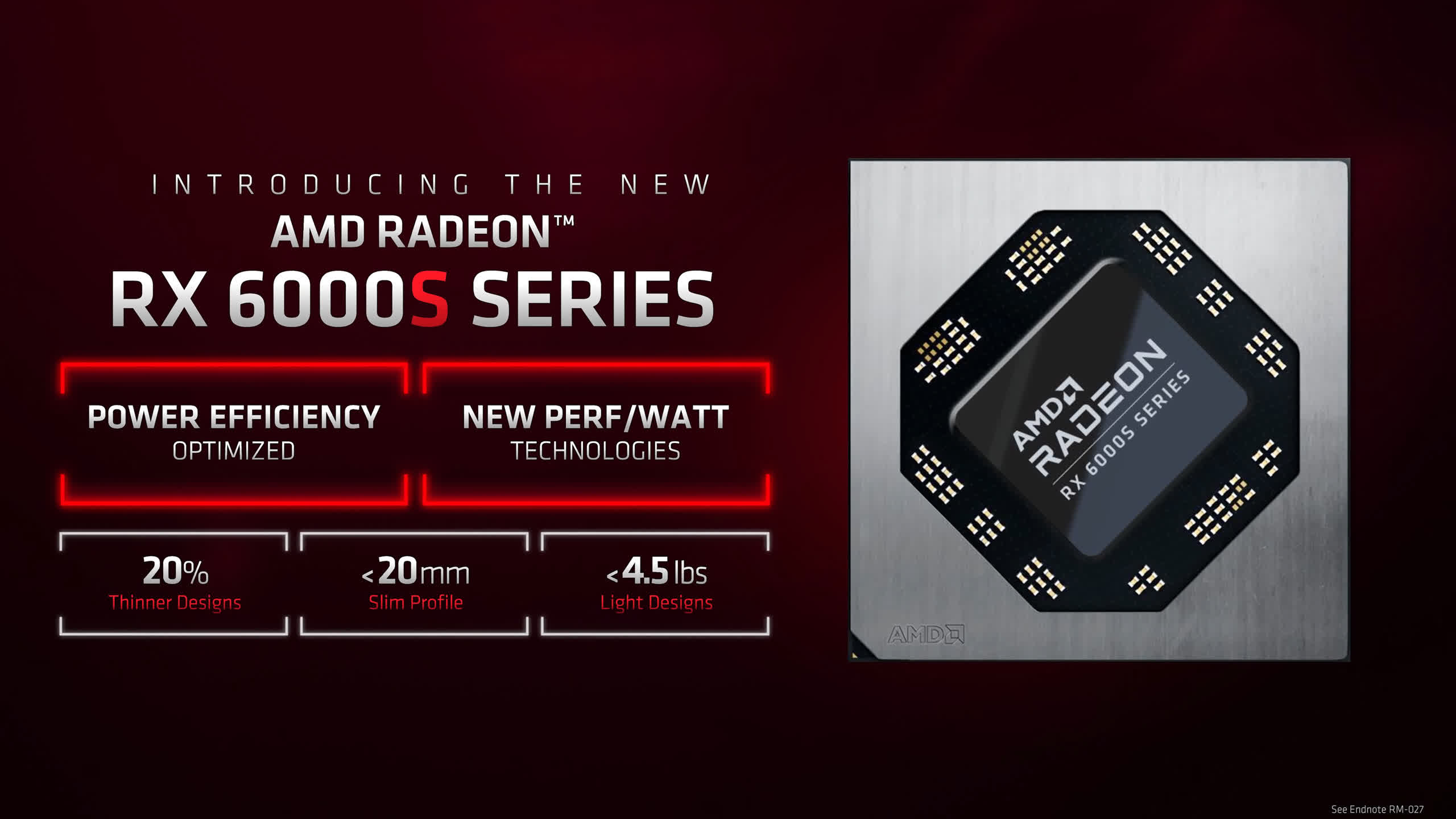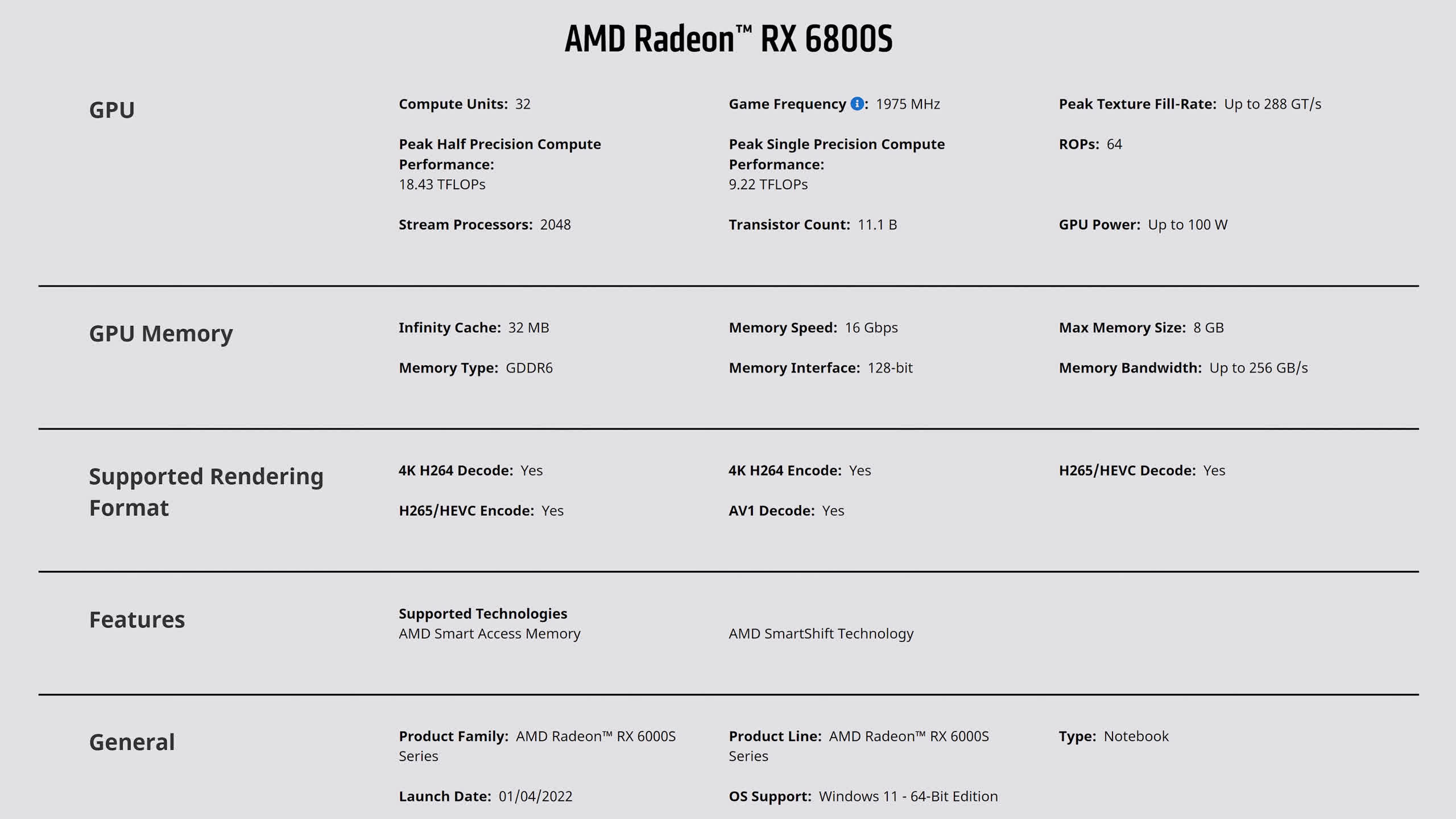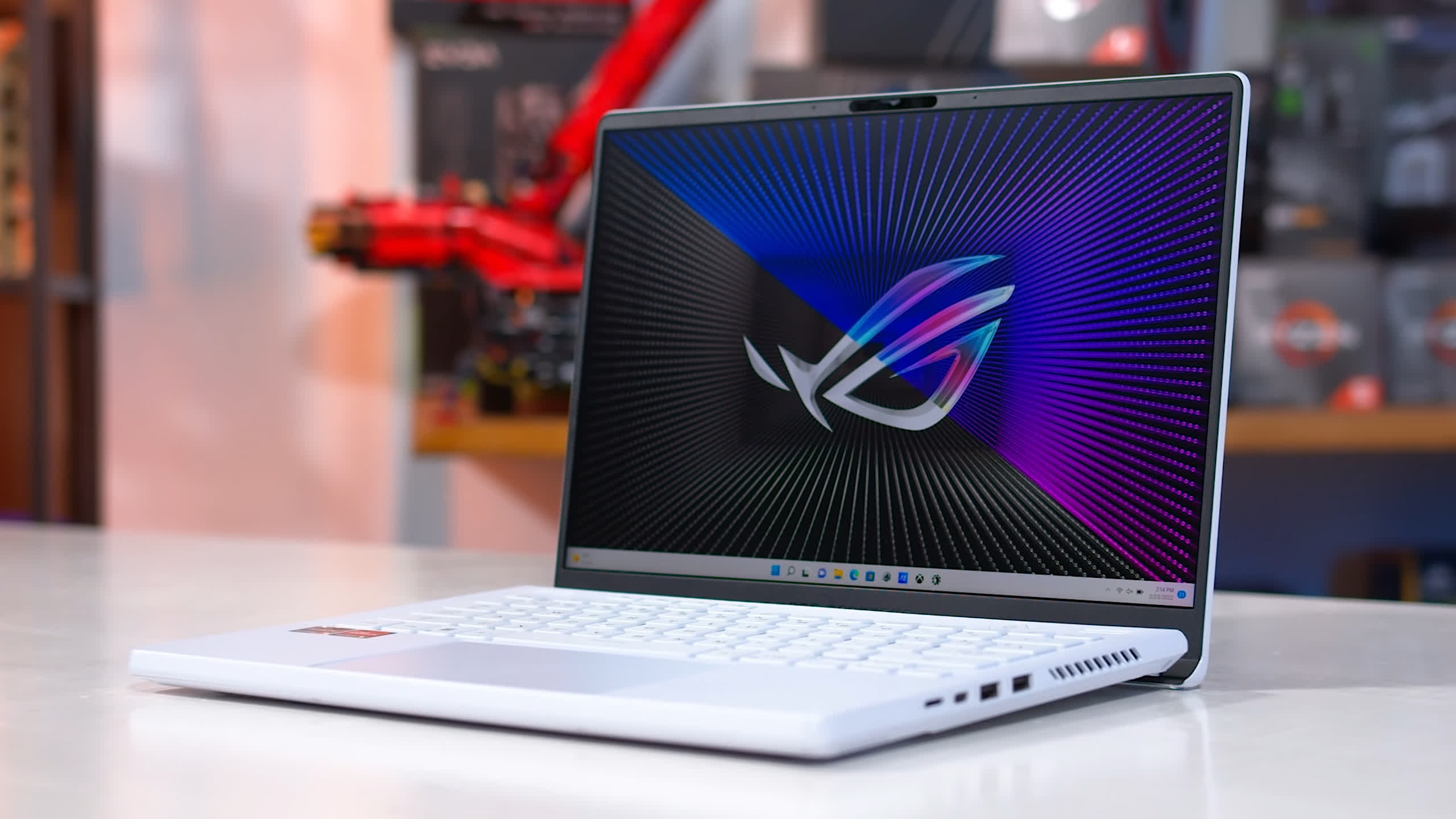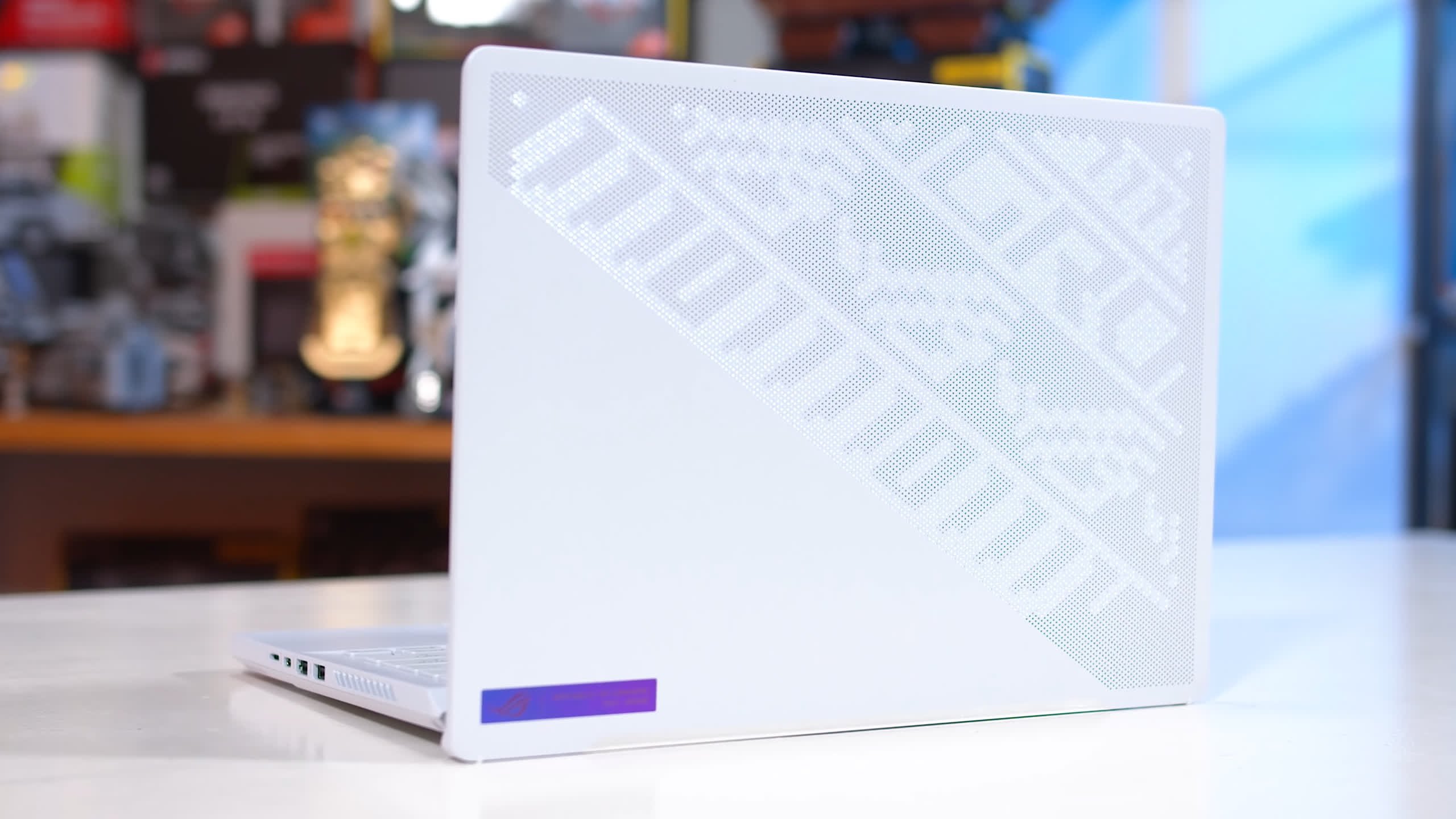The Radeon RX 6800S is AMD’s latest attempt at doing something special in the gaming laptop market. The 6800S is a lower-power, higher-efficiency version of the Radeon RX 6800M that we reviewed last year, in a similar vein to what Nvidia has been doing the last few years with what used to be Max-Q products.
Instead of targeting the 115-150W power range for big beefy laptops, the idea is that these efficient parts will target around 80-100W, so they can be included in thinner and more portable systems like the Asus Zephyrus G14 that we are using for today’s test.
Setting aside the naming issues we see with Nvidia mobile graphics offerings, the company has seen success with their low-power GPU variants. Various ultraportable gaming designs like the Razer Blade, Gigabyte Aero and MSI Stealth, are all using them. AMD had a full line of high-power laptop GPUs, but nothing to answer Max-Q type graphics. If a vendor wanted to put an 80W AMD GPU in their system, the only choice was an RX 6600M which is more of a competitor to the RTX 3060 than higher-end gaming parts. That’s where the Radeon RX 6800S comes in.
How AMD has created an efficient laptop GPU is a little different to Nvidia. When Nvidia takes a 150W GPU down to 80W, they simply reduce clock speeds and give that GPU the exact same name, a tad confusing for customers, but the end product is effective. What AMD has done to bring the 6800M down to a 6800S is to actually change the silicon, instead of getting 40 compute units in the 6800M, the 6800S has 32 CUs, lower than the RX 6700M’s 36 CUs. This is a full die swap from Navi 22 down to Navi 23.

As a result, AMD doesn’t have to drop clock speeds as significantly. We go from a 2300 MHz game clock with the 6800M down to 1975 MHz for the 6800S. But there are more implications to discuss: the Navi 23 die features less infinity cache (32MB vs 96MB) and the memory subsystem has changed. The 6800S gives you just 8GB of 16 Gbps GDDR6 memory on a 128-bit bus, versus 12GB of 16 Gbps GDDR6 memory on a 192-bit bus with the 6800M.
So, while the 6800S and 6800M share a similar name, the S vs M aspect is super important, as these GPUs are nothing alike. It probably would have made more sense to call this the 6700S, but then there’s a separate 6700S which is its own product… the key to this information is that you are careful about what GPU you’re buying.

As for desktop equivalents, it shouldn’t come as a surprise that the 6800S is not even close to AMD’s Radeon RX 6800 or 6800 XT. The 6800M was already miles off those GPUs in terms of specifications and performance. In this case, the 6800S is actually very similar to a desktop 6600 XT brought across to laptop form factors. The core configuration and memory is the same, but the desktop 6600 XT is clocked higher and features a higher 160W TDP.

Our test system for today’s review is the Asus Zephyrus G14, which we looked at previously when testing the Ryzen 9 6900HS processor. Other specs include 32GB of DDR5-4800 memory in a dual stick configuration, and a 14-inch 2560 x 1600 IPS display at 120Hz. While this is a unique resolution, to allow for apples-to-apples comparisons to other GPUs, we’ll be benchmarking at 1080p with the GPU routed through the iGPU, a typical laptop use case; and 1440p using an external display, which is the most GPU limited test scenario we have right now.
Gaming Benchmarks
Kicking things off with Assassin’s Creed Valhalla at 1080p, this title has always favored AMD hardware, even after a recent update that did significantly improve performance on Nvidia GPUs.

But still, the 6800S is actually the fastest configuration we’ve tested, with Resizable BAR – enabled here – helping things out. The 6800S ends up 16 percent faster than the RTX 3070 Laptop GPU running at 90-105W which is the most similar configuration we had on hand.

At 1440p, the gap between AMD and Nvidia closes to just 6 percent on average, though AMD with the 6800S has a sizable advantage in 1% lows. The 6800S holds up remarkably well compared to much more power-hungry parts like the RTX 3070 Ti and RTX 3080 Ti laptop variants, so in this game you can get quite a lot of performance out of a small 14-inch design.


In Watch Dogs Legion, we see a more typical result for the 6800S at 1080p using Ultra settings. This new GPU is 20 percent faster than the 6600M despite using a similar power range, and 13 percent faster than the RTX 3070 Laptop GPU at 90W. The fact the 6800S can sit between the full power RTX 3070 and RTX 3080 is a very solid result. However, when we look at 1440p numbers, the 6800S simply is not as strong, now performing similarly to the RTX 3070 at 90W – slower for average FPS, faster for 1% lows.


In Far Cry 6 we’re seeing performance that’s pretty much as expected, the RX 6800S matches the RTX 3070 in terms of average performance, though the 3070 falls away for 1% lows like we’ve seen in Watch Dogs Legion. The gap for 1% lows gets even larger at 1440p, where 8GB of VRAM for the RTX 3070 seems to be an issue, whereas the same 8GB of VRAM isn’t as much of an issue for the 6800S. The laptop RTX 3070 has a lot more memory bandwidth than the 6800S, so the differences may amount to optimization and AMD’s Infinity Cache implementation.


Metro Exodus sees the RX 6800S outperform the RTX 3070 at 90W again, though by just 5 percent. There’s quite a gap to the full power RX 6800M, the 6800S ends up 17 percent slower at 1080p, though that’s a fairly typical margin between full power and low power GPU variants. The RTX 3070 at 90W is 16% slower than its full power variant as well. Meanwhile at 1440p, Nvidia’s RTX 3070 takes the lead and the 6800S comes in 10 percent slower, so there’s quite a swing here between 1080p and 1440p performance, going from 5 percent faster to 10 percent slower.


In Red Dead Redemption 2 at 1080p the RX 6800S and RTX 3070 at 90W deliver identical performance. The low power 6800 variant is 15% slower than the full power model, but it still does have an edge on the RX 6600M, so we’re more looking in the range of high power RTX 3060 to RTX 3070 territory. Then at 1440p we see the 6800M fall behind the RTX 3070 by 7 percent, and it also falls further behind the 6800M, now by 22 percent. The Navi 23 die with less memory bandwidth and a smaller Infinity Cache just isn’t as well optimized for 1440p gaming as Navi 22, which is used for the 6800M.


In Cyberpunk 2077 with ray tracing disabled, the 6800S and RTX 3070 at 90W again deliver pretty similar performance at 1080p. However we see the largest margin yet between the 6800M and 6800S; the S model is 19 percent slower and this is just at 1080p. When we move up to 1440p testing, the 6800S falls 29 percent behind, and also 15% behind the RTX 3070. Delivering just over a 30 FPS experience, the 6800S just doesn’t seem that well optimized for 1440p, at least compared to higher tier GPU options.


In Guardians of the Galaxy, the 6800S and RTX 3070 again perform very similarly, although the 3070 has an edge with 1% low performance. This is also one of the smallest margins seen between the 6800S and the 6600M, which have similar power limits. Then we move up to 1440p and the 6800S falls behind the RTX 3070 to the tune of a 12 percent margin, which again is pretty typical. If the 6800S and RTX 3070 perform about the same at 1080p, you can bet the Radeon option will be slower at higher resolutions.


Forza Horizon 5 was a pretty strong result for the RX 6800S, almost getting to the level of high performance GPUs like the RTX 3070 Ti at 1080p when looking at average frame rates. This meant the 6800S was 15% faster than the RTX 3070 at 90W, one of the largest margins in favor of AMD’s GPU. But when we move up to 1440p the margins aren’t quite as large, the 6800S still is in the leading position, though it’s just 6 percent faster than the RTX 3070 now.


The last title we’re looking at for rasterization performance is Resident Evil Village. At 1080p this is another very strong result for the 6800S, capable of sitting between the RTX 3070 Ti and RTX 3080 Ti was unexpected. The 6800S was a massive 20 percent faster than the RTX 3070 at 90W in this title, and we see a respectable margin at 1440p as well: the 6800S was 14 percent faster. This is an AMD sponsored title and simply runs very well on the 6800S.
Ray Tracing Performance
What doesn’t run very well on the 6800S is ray tracing. When playing Guardians of the Galaxy using the maximum ray tracing preset at 1080p, the 6800S isn’t significantly faster than the 6600M and falls hugely behind the RTX 3070 at 90W without using any upscaling technique like DLSS or FSR.

It’s no contest, the RTX 3070 delivers playable ray tracing performance at a native 1080p, while the 6800S does not. Unsurprisingly, the 6800S fares even worse at 1440p where it can’t even average 30 FPS with ray tracing turned up to the max, which is relatively easy for the RTX 3070 at 90W.

Resident Evil Village was one of the best results for AMD in rasterization performance, but that’s not the case when looking at ray tracing in the same game. The 6800S is 20 percent slower than the RTX 3070 at 90W when looking at both 1080p and 1440p data, which effectively puts the 6800S a tier or two below the RTX 3070 if you want to play with ray tracing enabled. The 6800S is still playable at both resolutions though, especially if you’re just targeting around the 60 FPS mark.

Far Cry 6 is the most favorable result for ray tracing in the 6800S vs RTX 3070 comparison. The RTX 3070 struggles a bit with its memory system when ray tracing is enabled in conjunction with the HD texture pack, even at 1080p. When moving up to 1440p, the RTX 3070 is a bit of a stutter fest whereas the 6800S seems to cope relatively well, and that’s despite both GPUs using 8GB of VRAM. We suspect optimization for AMD hardware and the use of Infinity Cache is saving the 6800S from a worse result.

For every good result, there’s a bad result. The 6800S is pretty useless when attempting to use ray tracing in Cyberpunk 2077. The 6800S simply cannot cope with the intense use of RT in this game, and fails to reach anywhere near 30 FPS without FSR enabled (and even then, struggles at a huge hit to visual quality). The RTX 3070 is simply twice as fast here, and can benefit from DLSS which delivers superior image quality at 1080p. Don’t even make me talk about the 1440p data for long because the 6800S result is dismal and the RTX 3070, while a lot faster, also fails to get anywhere near 30 FPS.
Should You Avoid This Radeon Mobile GPU?
Going into this performance review, we were a bit skeptical of AMD’s approach to making a low power GPU with the Radeon RX 6800S. Typically, the path to success for making efficient products has been to keep the core relatively large, but reduce clock speeds to hit that efficiency sweet spot in the voltage-frequency curve.
This has been an effective tactic for CPUs and GeForce GPUs. But AMD didn’t do that with the 6800S, instead choosing to cut down the entire GPU including the memory configuration compared to the full-power 6800M.

Despite this, the 6800S is a relatively successful low-power GPU. The drop in performance compared to the 6800M is similar to what we’ve before from Nvidia GPUs going from a full power variant down to the lower-power “Max-Q” model.
The 6800S is competitive with the RTX 3070 at 90W, which is used in many portable laptop designs, especially at 1080p where the 6800S is on average 8 percent faster for rasterization performance. That should put it around the mark of Nvidia’s best Max-Q GPUs, though obviously a fair bit behind the fastest GPUs you can get. These chips are designed for slim and light systems after all and simply can’t be run at 125 to 150W.
However, the RX 6800S suffers from the same issues we’ve seen from other Radeon mobile GPUs. The 6800S isn’t nearly as competitive at higher resolutions like 1440p, and a lot of laptops are coming to market these days with 1440p displays and MUX switches built in.
The Zephyrus G14 is one such example with its 2560 x 1600 display. At 1440p, the 6800S is neck and neck with the RTX 3070 at 90W for rasterization, if not a little slower. The 6800S however is AMD’s highest tier configuration for ultraportable gaming systems, and we don’t think it’d be able to go toe to toe with the RTX 3080 Ti.

The 6800S also suffers badly in ray tracing performance, falling well behind the RTX 3070 in most instances. It’s a double whammy here, because not only is AMD’s RDNA2 ray tracing performance slower than Nvidia’s Ampere, but the Navi 23 die used here also isn’t that suited to ray tracing with its limited Infinity Cache and mediocre memory system. The 6800S should be a 1440p + ray tracing class GPU, but AMD decided to use their 1080p class GPU for the task, which is also seen in the 6600 XT desktop card.
Then we have the usual list of Nvidia bonuses that you don’t get with an AMD GPU. DLSS in particular is much more effective than FSR at laptop resolutions like 1080p (and FSR works on Nvidia GPUs, too). Plus, stronger encoder support, though on a laptop this is probably more for capturing gameplay than streaming it. Nvidia has also been able to counter AMD’s SmartShift feature with their own equivalent, Dynamic Boost, and in our testing the RX 6800S + AMD CPU configuration used about as much power at the wall as an Intel + Nvidia combo using the RTX 3070 at 90W.
AMD has had an advantage in the past when it comes to laptop pricing. Last year the Asus ROG Strix G15 with the Radeon RX 6800M was an excellent deal up against similar gaming systems with Nvidia GPUs. That’s also generally the case with the Zephyrus G14 and the 6800S, but we are talking about a fairly unique design and a sample size of one. The Zephyrus G14 with the 6800S costs $1,900, which is much cheaper than something like a Razer Blade 14, but we still think they need to price their hardware lower to be competitive, especially if AMD wants to gain market share.
Shopping Shortcuts
- AMD Radeon RX 6800S Laptops on Amazon
- AMD Radeon RX 6800M Laptops on Amazon
- AMD Radeon RX 6600M Laptops on Amazon
- AMD Ryzen 9 6900HS Laptops on Amazon
- Asus ROG Zephyrus G14 on Best Buy
- Intel Core i7-12700H Laptops on Amazon
- GeForce RTX 3080 Ti Laptops on Amazon
- GeForce RTX 3060 Laptops on Amazon

